Dog Anxiety: How to Keep Dogs Calm
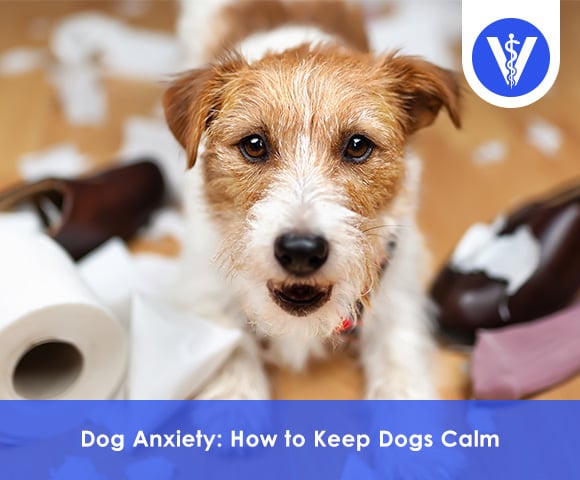
Table of Contents
Dog anxiety is when dogs fear real or imagined future dangers. Moderate dog anxiety is normal, but intense anxiety has a disruptive or destructive effect on the dog. Dogs with anxiety live in fear, which harms life quality.
Anxiety in dogs is caused by many factors, including genetics, being left alone, loud noises, car rides, veterinary visits, meeting new people, past traumatic events, old age, and medical conditions.
The signs of anxiety in dogs depend on the dog and anxiety type. Dog anxiety symptoms are panting, excessive vocalization, shivering, drooling, restlessness, paw licking, destructive behaviors, increased vigilance, whining, barking, and changes in sleep patterns.
Dog anxiety is manageable through behavior modification, anxiety medications, and alternative calming approaches. There is no one-fits-all treatment because all dogs are different, and it takes time to determine the best combination of techniques.
Reading the dog’s body language, creating a safe environment, and using calming aids help during anxiety. Building confidence, training, socialization, and physical and mental stimulation minimize or prevent anxiety in the long run.
What is Dog Anxiety?
Dog anxiety is fear of impending danger or disaster manifesting in multiple ways, from shivering, whimpering, and drooling to whining, barking, and panting. Anxiety in dogs is widespread, affecting more than 70% of the modern canine population.
MSD Veterinary Manual says that “anxiety is the apprehensive anticipation of future danger or misfortune, which may be accompanied by both behavioral and somatic signs.”
Canine anxiety is an umbrella term covering anxiety, fear, and stress. The three conditions are similar and harm the dog’s quality of life, but the conditions are not the same.
Fear is a graded response to a specific trigger whose intensity is proportional to the trigger’s proximity. Fear is normal and a part of the dog’s adaptive response when a definite threat causes the trigger.
Stress is a continuous state occurring when the anxiety episodes are excessive and become a permanent problem. Stress in dogs harms mental and physical wellness.
How Do Dogs Experience Anxiety?
Dogs experience anxiety by becoming fearful, aggressive, or clingier than usual. Anxiety in dogs does not have a universal clinical manifestation. Dogs are different and experience anxiety diversely, with signs ranging from disruptive to destructive.
The typical dog anxiety symptoms, like panting, drooling, and shivering, are present in some cases, while other dogs experience anxiety uniquely and show signs like displacement behavior, compulsive disorders, and changes in the sleep-wake cycle.
Experiencing anxiety harms the dog’s life quality, and long-term dog anxiety results in physical problems. Prolonged anxiety lowers the dog’s threshold for specific ailments, increasing the risk of allergies and inflammatory bowel disease (IBD).
Scientific Report published a study titled “Prevalence, comorbidity, and breed differences in canine anxiety in 13,700 Finnish pet dogs” in 2020. The study says that “anxious dogs may be more vulnerable to diseases and show decreased lifespan.”
What are the Causes of Anxiety for Dogs?
The causes of anxiety for dogs are listed below.
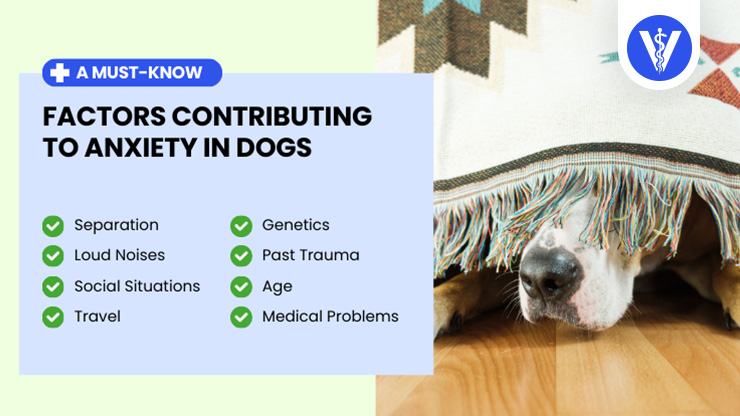
- Separation: Being left alone is a significant cause of anxiety in dogs. Dogs that have been abandoned in the past and certain breeds are more sensitive to being away from the owner. Labrador Retrievers, Border Collies, German Shepherds, Bischon Frises, Toy Poodles, and Jack Russel Terriers are triggered when left alone.
- Loud Noises: Loud noises cause anxiety in sounds-sensitive dogs. Common triggers include thunders, fireworks, traffic, alarms, sirens, construction work, and noisy house appliances like vacuum cleaners, blenders, hairdryers, or washing machines. Dogs have a superior sense of hearing and respond to noises that aren’t ear-piercing.
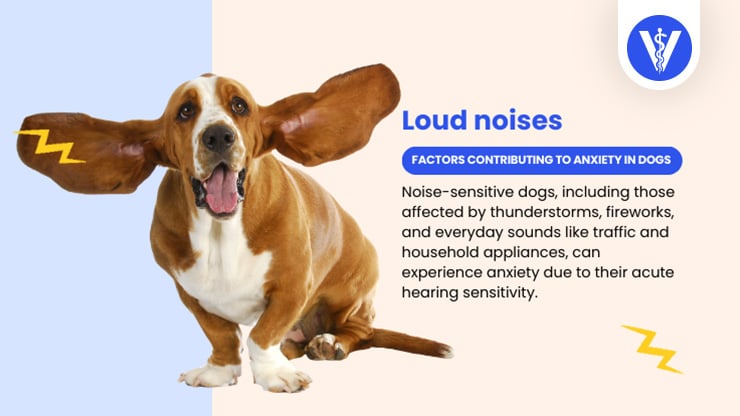
- Social Situations: Social situations like seeing new people, animals, and environments cause anxiety in dogs not adequately socialized as puppies. Lack of socialization is the most common cause, but fearful experiences and genetics cause dog anxiety in social settings. Dogs with social anxiety are triggered by sights, sounds, and smells in a new situation rather than the situation itself.
- Travel: Travel, particularly long car rides, causes anxiety in dogs for several reasons, including a lack of understanding of the situation, associating the car ride with a previous unpleasant experience like visiting the veterinarian or being left at a boarding facility, and motion sickness, which is common in puppies.
- Genetics: Anxiety occurs in all dogs but develops at higher rates in certain breeds. Studies show that anxiety-prone breeds include the Lagotto Romagnolo, the Wheaten Terrier, the Spanish Water Dog, the Shetland Sheepdog, the Miniature Schnauzer, and mixed breed dogs. The genetic makeup influences the type of anxiety present. For example, Wheaten Terriers are most likely to be triggered by noises, and Spanish Water Dogs by strangers.
- Past Trauma: Bad experiences in the past make dogs anxious years after the traumatic event. The anxiety stems from various situations, such as physical abuse, abandonment, such as being left on the street or in a shelter, and neglect. Dogs with past trauma are easily triggered and generally feel unsafe.
- Age: Getting older, or age-related conditions, causes anxiety in senior dogs. Older dogs experience a decrease in the smell, sight, and hearing senses, making them startle easily. Canine cognitive dysfunction (CCD), a condition similar to Alzheimer’s in humans, is a cause of anxiety in older dogs.
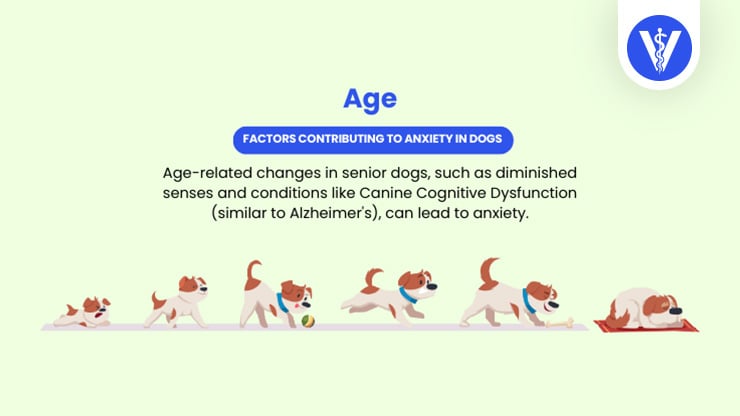
- Medical Problems: Painful medical conditions cause anxiety in dogs. Arthritis, brain ailments like encephalitis, sense-impairing issues such as vision loss and deafness, and hormonal imbalances including hypothyroidism, Cushing’s disease, and diabetes induce anxiety. The anxiety symptoms in dogs with these medical problems are masked by the symptoms caused by the original disease.
What are the Signs of Dog Anxiety?
The signs of anxiety in dogs are listed below.
- Excessive Vocalization: Howling, whining, and barking are types of vocalization and, when exaggerated, are signs of anxiety in dogs. Stressed dogs vocalize more than usual to catch the owner’s attention and demonstrate anxiety.
- Panting and Pacing: Panting not associated with exercise and hot temperatures is a sign of dog anxiety and is seen in conjunction with pacing. Stressed dogs are nervous and restless and tend to pace around the house and garden.
- Shivering and Trembling: Shaking is a sign of anxiety in dogs. Shaking, shivering, or trembling occurs in anxious dogs because adrenaline floods the system, readying the muscles for action in the case of an emergency.
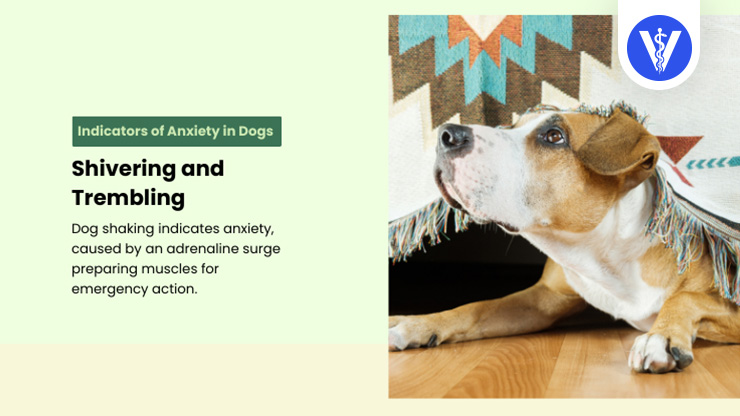
- Exaggerated Drooling: Lavish drooling or hypersalivation occurs in nauseated dogs and is an anxiety sign. Drooling is normal in some breeds and is a sign of dental disease. Rule out other causes before accrediting the symptom to anxiety.
- Running Away and Cowering: Anxious dogs run away, hide, and cower in a safe spot when presented with a stressful situation. The behavior results from the natural fight or flight response in all mammals and humans.
- Heightened Vigilance: Anxious dogs are more alert than usual and always on the lookout for potential danger. Increased agitation and bad reactions to otherwise normal situations are signs of dog anxiety.
- Destructiveness: Destructive behavior is an expected sign of anxiety and includes excessive chewing, digging, and scratching. Dogs vary in destructiveness based on their size and power.
- Inappropriate Elimination: House-soiling or urination and defecation inside the house in potty-trained dogs suggests anxiety. Strong emotions, like stress, affect the dog’s ability to control the bladder and bowels, resulting in inappropriate indoor elimination.
- Changes in Sleep-Wake Cycle: Anxious dogs experience changes in sleep-wake patterns, and the lack of sleep increases stress. A change in the dog’s sleeping schedule indicates anxiety when no explanation exists.
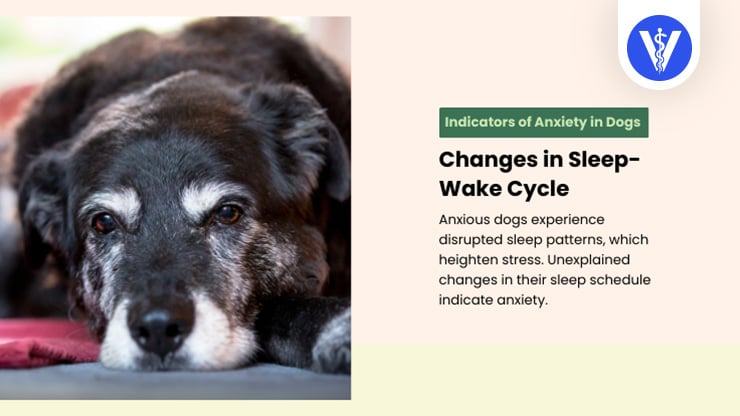
- Repetitive or Compulsive Behaviors: Tail chasing, spinning in circles, overindulged grooming, fly biting, checking the hind end, and licking of objects are among the most common repetitive or compulsive behaviors in dogs, indicating stress.
- Self-Harm: Excessive licking or chewing paws is a sign of anxiety in dogs and is self-harmful. Prolonged and intense licking and chewing result in skin irritation and potential skin infections.
What are Different Anxieties Dogs Experience?
The different anxieties dogs experience are listed below.
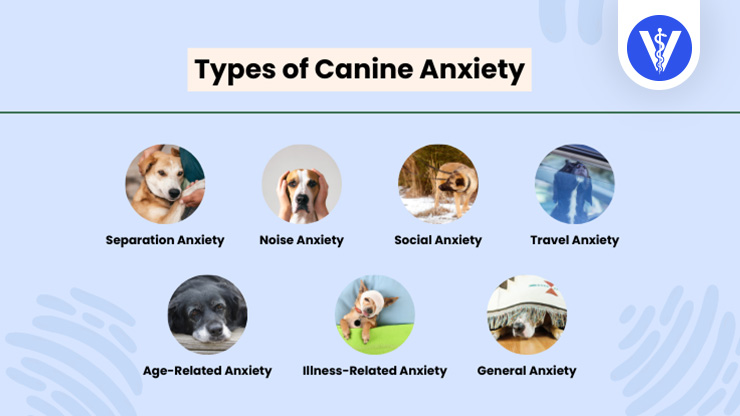
- Separation Anxiety: Separation anxiety affects 14% of dogs and is a frequently reported anxiety type. The incidence of separation anxiety spiked by 700% following the Covid-19 pandemic. Dogs with separation anxiety are upset and unable to find comfort when left alone. Separation anxiety makes dogs prone to destructive behaviors, excessive vocalization, and inappropriate urination.
- Noise Anxiety: Noise anxiety, or as medically termed noise phobia, is defined as excessive fear of sounds. Noise anxiety affects one-third of the canine population. Dogs of all breeds and ages are susceptible to developing a persistent, intense, and irrational fear of noise. Moderate fear of noises, like startling when thunder strikes, is normal, but exaggerated responses are maladaptive in dogs.
- Social Anxiety: Social anxiety occurs when an unsocialized or traumatized dog meets strangers and new animals or when presented with an unknown environment. Dogs with social anxiety are typical in familiar situations but turn on the fight-or-flight response when stressed. A dog with social anxiety gets either aggressive or goes into hiding when faced with the trigger.
- Travel Anxiety: Travel anxiety is usual in dogs. Car rides and other modes of transport are triggers. Puppies and dogs with sensitive stomachs develop travel anxiety because feeling nauseated is stressful and fuels the anxiety. Travel anxiety makes dogs yawn, whine, shiver, drool, lick their lips excessively, and vomit.
- Age-Related Anxiety: Dogs experience cognitive dysfunction with age. Cognitive dysfunction decreases the dog’s memory, awareness, and learning skills and dulls the senses, which leads to increased confusion and age-related anxiety. Senior dogs with age-related anxiety behave out of the ordinary and are irritable, snappy, or aggressive.
- Illness-Related Anxiety: Illness-related anxiety is an underdiagnosed issue in dogs. Medical conditions, like pain, alter how the dog perceives or responds to potential stress-triggering stimuli, and the medical condition suppresses the symptoms of dog anxiety.
- General Anxiety: General anxiety is a type of anxiety occurring without a specific trigger. Dogs suffering from general anxiety are prone to destructive behaviors like digging, chewing, scratching, excessive vocalization, and exaggerated attachment to the owner.
What are Treatments of Dogs Anxiety?
The treatments for dog anxiety are listed below.
- Behavior Modification: Behavior modification is a long-term process that stops the dog’s unwanted behaviors or reduces them to a manageable level. The approach includes counterconditioning and desensitization. Counterconditioning is based on replacing the dog’s negative perception of the stress trigger with a pleasant experience. Desensitization entails the gradual exposure of the dog to low-level stress stimuli until it gets resistant. Successful behavior modification requires the help of a licensed dog trainer or professional canine behaviorist.
- Anxiety Medications: Anxiety drugs are used in dogs with severe anxiety and dogs that do not respond to other management approaches. The exact medication is chosen based on the type of anxiety and must be prescribed by a licensed veterinarian. Using over-the-counter calming medications in dogs is dangerous. Anxiety medications for dogs include diphenhydramine (Benadryl®), Lorazepam (Ativan®), Alprazolam (Xanax®), Diazepam (Valium®), Sertraline (Zoloft®), Dexmedetomidine (Sileo®), Buspirone (BuSpar®), Fluoxetine (Prozac®), Trazodone (Desyrel®), and Clomipramine (Anafranil®).
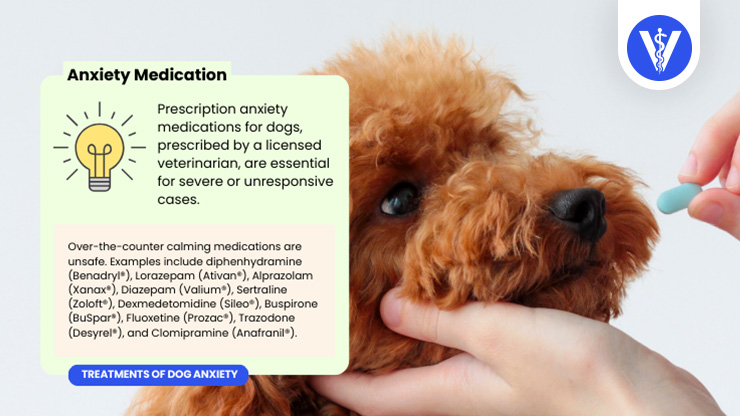
- Alternative Solutions: Alternative approaches help manage anxiety in dogs. The alternative methods are efficient alone or need to be combined with other techniques depending on the anxiety type and severity. Alternative dog anxiety treatments include CBD or cannabidiol oils, dog-appeasing pheromones or DAP, aromatherapy, calming beds and crates, PEMF or pulsed electromagnetic field, therapy, music, thunder shirts, calming supplements formulated with chamomile, valerian root, passion flower, l-theanine, and l-tryptophan.
How to Keep the Dog Calm During Anxiety?
To keep the dog calm during anxiety, follow the instructions listed below.
- Give a Calming Aid. Using calming supplements and medications takes time to start working and achieve relaxation. Calming supplements and medications include natural CBD oils and prescription anxiety drugs.
- Create a Safe Space. Dogs have natural denning behavior. Create a safe place for the dog to retreat when strong feelings overwhelm. The safe place is ideally dark, free from noises, and filled with some of the dog’s favorite possessions, like toys and blankets.
- Play Stimulating Games. Playing redirects the dog’s focus from the stressful stimuli to the game. Puzzle games, Kong wobblers, and treat balls are some of the best interactive games for managing dog anxiety.
- Provide Physical Contact. Pet or cuddle the dog for calmness during anxiety episodes. Physical contact is very effective and promotes the release of the hormone oxytocin, which has a powerful calming effect on dogs.
- Massage the Dog. Massaging dogs helps relieve stress. There are many massaging techniques to try and see which allows the dog the best.
- Try Alternative Solutions. Dogs respond to anxiety treatment uniquely. Try various approaches, including thundershirts, calming beds and crates, music therapy, aromatherapy, PEMF therapy, DAP, or dog-appeasing pheromones.
What Should the Owner Do to Minimize Dog’s Anxiety?
The owner should learn to understand the dog’s body language, exercise regularly, provide plenty of mental stimulation, and invest time in proper training and socialization to minimize the dog’s anxiety.
Tense or anxious body language demonstrates how the dog is feeling. Reading the dog’s emotions through body language allows the owner to act to stop the anxiety from escalating to an anxiety episode.
Exercise and mental stimulation are vital in minimizing dog anxiety. A physically and mentally challenged dog does not focus on stressful triggers like a bored dog. The owner must create an exercise program and ensure ample mental stimulation.
Training and socialization help the dog build confidence, which is the opposite of anxiety. Basic obedience training and early exposure to new people, pets, and situations help boost the dog’s confidence and prevent or minimize dog anxiety in the long run.
How Can CBD Treat Dogs’ Anxiety?
CBD treats dog anxiety by promoting natural calmness and relaxation through the ECS or endocannabinoid system. The ECS is a complex regulatory system in mammals that balances vital body functions.
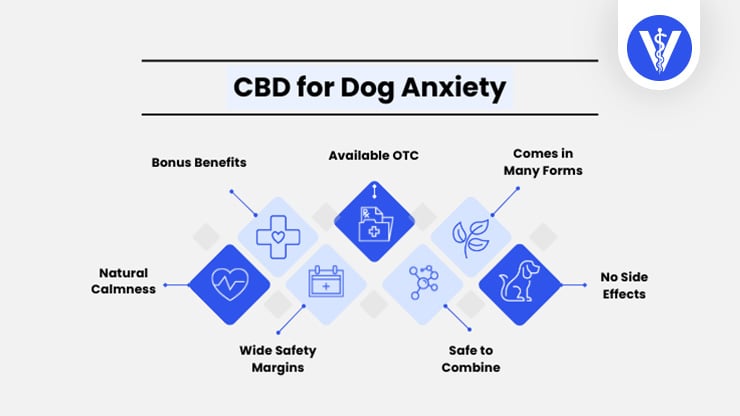
CBD, or cannabidiol, is a naturally occurring compound found primarily in the hemp version of the cannabis plant. Cannabidiol is health-boosting, non-addictive, and non-psychoactive.
Dogs with anxiety calm down when CBD oil is given 30 to 45 minutes before the stressful event. Dogs with generalized anxiety benefit from regular daily use of CBD products. CBD is safe to combine with mainstream anxiety medications in dogs with severe episodes.
What are CBD’s Properties that Helps Treat Dogs’ Anxiety?
CBD has two main properties that help treat dog anxiety, including serotonin-mimicking and anxiolytic or panicolytic effects.
CBD for dogs binds with the 5-HT1a serotonin receptors and mimics the effects of the feel-good hormone serotonin, giving a sense of relaxation. Danilo de Gregorio and associates published a study in 2019, “Cannabidiol modulates serotonergic transmission and reverses both allodynia and anxiety-like behavior in a model of neuropathic pain.” The scientists concluded that CBD “reduces anxiety through 5-HT1A receptor activation.”
The anxiolytic or panicolytic effects of CBD are documented in a 2021 study, “Anti-Aversive Effects of Cannabidiol on Innate Fear-Induced Behaviors Evoked by an Ethological Model of Panic Attacks Based on a Prey vs. the Wild Snake Epicrates cenchria crassus Confrontation Paradigm.” A group of mice given CBD showed reduced defensive behaviors when introduced to a snake.
CBD for dogs helps manage various anxiety types, including separation anxiety, noise phobias, and car travel. CBD reduces aggressive behaviors, promotes good sleep, and helps manage post-traumatic stress, which helps with anxiety.
A study, “The Positive Behavioral Impact of a CBD-containing Nutraceutical Formulation on Privately-Owned Dogs,” from 2021, tested the effects of CBD on 20 anxiety-related unwanted behaviors in dogs. The results showed that CBD supplementation helped manage 19 out of the 20 examined behaviors.
What are the Benefits of CBD for Dogs’ Anxiety?
The benefits of CBD for dog anxiety are listed below.
- Natural Calmness: CBD supports natural calmness and relaxation by working through the dog’s endocannabinoid system. Natural products are safer to use long-term and have fewer side effects. High-quality CBD products are made with organic ingredients and are free from artificial additives, allergens, and genetically modified organisms or GMOs.
- Wide Safety Margins: CBD for dogs is sourced from hemp plants, is natural, and has a wide safety margin. CBD for anxiety control is safe to use in dogs of all sizes and puppies over four months old. Dogs cannot overdose on hemp-derived CBD products.
- Safe to Combine: Dog CBD products are natural and safe to combine with regular anxiety medications and other calming methods, like counterconditioning and desensitization. Talk to a veterinarian if using CBD and traditional calming drugs at the same time.
- No Side Effects: CBD for dogs does not cause severe or long-term side effects. Cannabinoids trigger temporary and benign adverse events in some dogs, but only until the dog gets used to the supplement and the proper dosage is determined. CBD does not build tolerance after prolonged use.
- Comes in Many Forms: CBD products for dogs are available in many forms, from oils to treats to capsules and various pet-friendly flavors. The wide variety of products and taste options make CBD easy to use. CBD oils work faster in providing dog anxiety relief than CBD treats and capsules.
- Available OTC: CBD for dog anxiety is over-the-counter (OTC) and easy to purchase online or in pet CBD stores. CBD for dogs with anxiety does not require a prescription, but consulting a veterinarian is recommended.
- Bonus Benefits: The benefits of CBD are not limited to anxiety relief. CBD for dogs supports natural wellness, strengthens immunity, boosts cognition, and helps treat various pet ailments, such as arthritis, allergies, glaucoma, seizures, and cancer.
What are the Side Effects of CBD for Dogs?
The side effects of CBD oil for cats are listed below.
- Lethargy: Low energy, increased sleepiness, and disinterest in daily activities are some side effects of CBD.
- Dizziness: Dizziness manifests with loss of balance and coordination or ataxia and is a rare CBD adverse reaction.
- Dry Mouth: Cannabinoids block saliva production, causing xerostomia or dry mouth in dogs using CBD.
- Vomiting: Vomiting is a frequent but self-limiting side effect of CBD and occurs in dogs with sensitive stomachs.
- Diarrhea: Diarrhea, manifesting with loose and frequent stool, is a CBD side effect, especially in dogs not used to the supplement.
- Upset Stomach: Stomach upset in dogs is a side effect of cannabinoids.
- Liver Enzyme Changes: CBD inhibits the liver’s cytochrome P450 enzyme, which alters the dog’s ability to metabolize drugs.
- Increased Tremors: Increased tremors are an infrequent adverse effect of CBD products for dogs.
- Increased Itchiness: CBD for dog anxiety increases itchiness (scratching, biting, and licking) in rare situations
- Low Blood Pressure: CBD drops the dog’s blood pressure, and hypotension is one of the main side effects of CBD.
How Much CBD to Give for Dog with Anxiety?
Give between one and five milligrams of CBD per 10 pounds of body weight per day for dogs with anxiety. Start slow with a lower CBD dose and gradually increase the amount to give the dog time to adjust and minimize side effects.
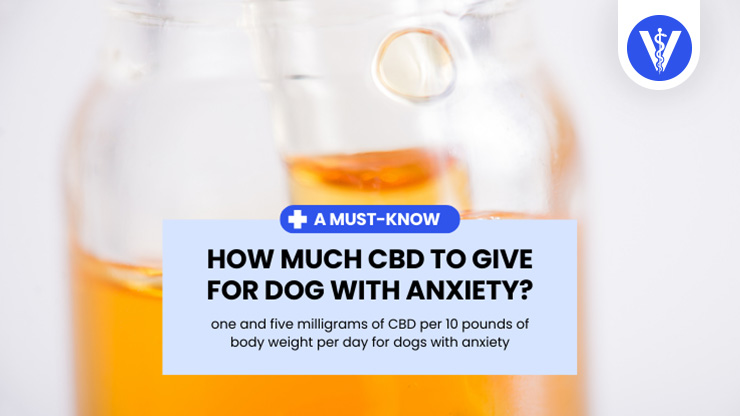
Dosing CBD for pets is not an exact science. Different dogs respond differently to CBD for dog anxiety, thus requiring lower or higher levels than the recommended. Consult the vet and read the product’s manufacturer guidelines to determine the best CBD dosage.
Are CBD Oil Safe for Dogs?
Yes, CBD oil is safe for dogs. Societal perceptions, lack of FDA approval, and local legal regulations prevent veterinarians from recommending CBD for dog anxiety management.
The answer is yes for pet owners wondering, “Is CBD safe” CBD for dogs is safe when sourced from the hemp plant, with veterinarian approval, and under the manufacturer’s instructions.
Annual Reviews of Animal Biosciences published a study, “Scientific Validation of Cannabidiol for Management of Dog and Cat Diseases,” in 2023, saying, “CBD appears to have good bioavailability and safety profile with few side effects.”
Can CBD Oil Help Dogs Calm Down?
Yes, CBD oil helps dogs calm down. CBD is a drug-free solution for dog anxiety and is easy to acquire, dose, and use. CBD oils for dogs are sourced from hemp and rich in cannabinoids with calming and anti-anxiety properties.
Frontiers in Veterinary Science issued a study, “A single dose of cannabidiol (CBD) positively influences measures of stress in dogs during separation and car travel,” in 2023. The study showed that one CBD application is enough to calm dogs with separation and travel anxiety.
CBD for dogs works naturally through the dog’s endocannabinoid system and does not build up in the body, meaning it does not cause tolerance with time. CBD is safe for dogs and puppies older than four months of age.
















